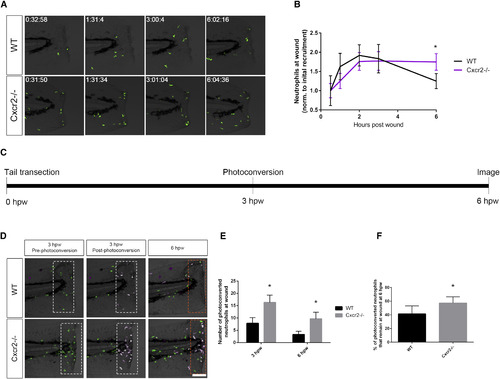Fig. 3
- ID
- ZDB-FIG-180907-7
- Publication
- Powell et al., 2017 - Chemokine Signaling and the Regulation of Bidirectional Leukocyte Migration in Interstitial Tissues
- Other Figures
- All Figure Page
- Back to All Figure Page
|
Neutrophil Reverse Migration Is Impaired in cxcr2 Mutants (A) Time-lapse imaging of Tg(mpx:Dendra) WT and Cxcr2−/− tail fins after wounding. (B) Quantification of average neutrophil presence at wound normalized to the average initial neutrophil recruitment to wound at 30 min post-wound (n = 11 WT and 14 mutant; one representative experiment). WT larvae exhibit neutrophil recruitment to wound peaking at 2 hpw with resolution back to 30 min post-wound levels by 6 hpw, whereas Cxcr2−/− larvae maintain high levels of neutrophil infiltration in the wound microenvironment at 6 hpw. (C) Schematic of photoconversion of Cxcr2−/− neutrophils at wound. Tg(mpx:Dendra) Cxcr2−/− larvae were wounded at 3 dpf. Photoconversion of Dendra+ neutrophils within the wounded tail fin (white dotted outlines in D) was performed at 3 hpw, and neutrophil reverse migration was assessed at 6 hpw. (D) Neutrophils pre- and post-photoconversion at 3 hpw and at 6 hpw were imaged in WT and Cxcr2−/−. (E) Quantification of photoconverted neutrophils in the wound microenvironment (magenta cells in dotted boxes, D; n = 25 WT and 30 mutants). cxcr2−/− wounds contained a higher level of photoconverted cells at 3 and 6 hpw. (F) Percent of photoconverted cells that remained at the wound at 6 hpw was calculated. Cxcr2−/− neutrophils remain at the wound at a higher frequency than WT neutrophils. ∗p < 0.05. Error bars represent SE. |
| Fish: | |
|---|---|
| Condition: | |
| Observed In: | |
| Stage: | Protruding-mouth |

